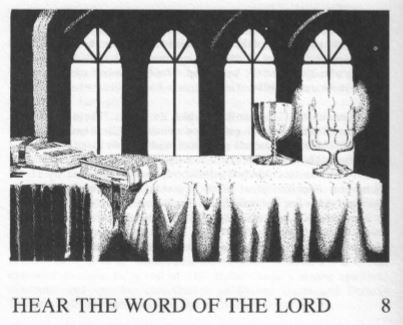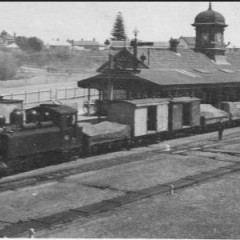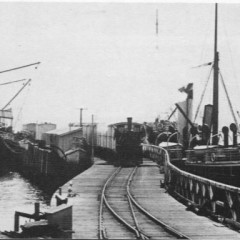8
Up until the late 1960s the most prominent features of centre-city New Plymouth were four large religious buildings. Since then they have been upstaged to some extent by temples of mammon in the shape of high-rise concrete office blocks and business houses. Each church is built on its own section of highly valuable land which many a commercial concern probably covets, lamenting the waste of good potential profit because they stand 'idle' and for the most part empty during business hours. But each church has a character which is lacking in many of its new neighbours, and each building-and the denomination it represents has a fascinating history, almost as old as the city surrounding it. For more than 100 years the churches were sacrosanct, a solace and a refuge for distressed souls, respected universally, and doors were never closed. With the march of 'progress' and materialism, and its accom- paniment of a depreciation of moral values, this, sadly, is no longer the case. But for the majority of citizens they are still houses of God. The main regard of the founding companies in England was the provision of land and the ability to live on it; and little official thought was apparently given to the spiritual needs of those who sailed from the West of England in the first ships (although the New Zealand Company favoured the Anglican Church with a grant). Perhaps they relied on the fact that Christian missions had already been established in various parts of New Zealand and would follow the lead of Samuel Marsden, who had preached the first sermon on Christmas Day, 1814, at his mission in the Bay of Islands, and that the spiritual needs of the country's settlers could be safely left to the missionaries. This, in fact, was the case. Although there was no clergyman aboard the William Bryan the first ship, which arrived at Ngamotu in 1841, there was among its company at least one able to fill the ecclesiastical void. He was the ship's surgeon, Henry Weekes. In his journal, written while still at seal he records: 'Read the morning prayers and a sermon. An ensign was thrown over the capstan which served as a desk. My assistant acts as clerk, having a good nasal twang. The passengers and many of the sailors attend in a very orderly manner.' And later: 'Performed divine service. An event happened today which I fear destroyed any little impression which my sermon may have left. Mr King entered the W.C. on the deck a few minutes before the commencement of the service and, as it had begun before he made his exit, rather than disturb the congregation, he remained in his "pew" during the whole service. But no sooner was it over than he thrust out his head (having on a peculiar plaid cap of the pancake cut) and created no little sensation truly.'
There to meet the settlers at Ngamotu was the Methodist minister, Charles Creed, who had already established a mission station near the foot of the present Bayly Road, and who had, on March 21, conducted the first divine service in Taranaki attended by Europeans (among them the members of Carrington's survey party). Creed was a remarkable man. Although he only stayed at Ngamotu for three years, and his 'parish' extended from Cook Strait to the Waikato, his mission was mainly with the Maoris. He had spent two years at Hokianga and Kaipara before sailing in the Triton, with the Rev. John Whiteley, the president of the Auckland Methodist Mission, intending to land at Patea. The weather was atrocious, so the Triton proceeded to Ngamotu a week after leaving Hokianga, 'and amidst great rejoicing of a crowd of Maoris the Creeds and their belongings were landed on January 14, 1841, the first European missionary in the Taranaki district'. Mrs Creed was the first European woman to come to Taranaki. The Creeds began work on 40 ha of land bought by Whiteley on January 13, 1840, after negotiations by Edward Meurant. This was the first recorded land sale in Taranaki, and the original deed is now held by the Taranaki Museum. The deed remained in possession of the Creeds until the publication of Benjamin Wells' History of Taranaki in 1878, when 'as a result of correspondence in the Taranaki Herald, Mr Creed forwarded it to the Grey Institute trustees. When the Hon. Oliver Samuel was investigating the title to the land in 1903, the deed was in his possession. There is here a strong point in favour of the trustees in their claim to unrestricted title to the land. When Commissioner Spain investigated this claim at New Plymouth in May, 1844, he was satisfied with its validity and did not ask for possession of the deed to include in his official papers. Had he done so it would no longer be in existence-all of Spain's papers are said to have been lost in the wreck of the White Swan on the Wairarapa coast in 1862. No lives were lost, but many valuable records went down with the ship. Providence in this case looked after the interests of the mission and church in the preservation of this valuable historic document.' Creed's mission in Taranaki was fraught with difficulties: even at that early stage of development there was much Maori dissatisfaction over land deals. The Rev. James Wallis, making a tour of inspection of mission stations, found the Creeds 'living in a small native-built house without either floor or fireplace, and in many other respects uncomfort- able, but they were happy in their work and seemed to lose sight of their many privations in their endeavours to improve the conditions of the natives among whom they live.
By 1843 the situation had apparently deteriorated. John Wicksteed, resident agent of the New Zealand Company, reporting to Colonel Wakefield on the effects of Commissioner Spain's land decision, said: 'The Maoris, stimulated by this document from headquarters, have given Captain King, Chief Police Magistrate, notice to quit and threatened to burn down the house of Mr Creed, Wesleyan missionary, unless he yields peaceable possession of the same to the native claimant. I have no fear that these threats will be put in execution, but they create annoyance and uneasiness. In my opinion the decision of Mr Spain, whose name has become a bye-word, would only be respected where favourable to the natives. The arrival of the Anglican Bishop Selwyn in New Zealand in 1842 accentuated a disturbing element in inter-church relations which had been evident ever since Bishop Pompallier had begun his Catholic mission, recruiting Maoris to the faith, as had other denominations. Selwyn was a typical High Church thinker of his day, and his appointment created stresses both within his own team and between them and the Wesleyans. He was convinced that his own men were the only people qualified to conduct the sacraments; that the Wesleyans were merely teachers and certainly not ministers. The same thing was said about Anglican orders by Pompallier and his staff. These religious diversions poisoned the streams of missionary life and left the Maori people perplexed beyond measure. A further result was to cause some of the chiefs who resisted the Gospel to justify continuing their heathen ways and to harden their opposition. If any question of church discipline arose over the behaviour of church members it was an easy way of escape to try to play one mission against another, and to change to another church of their choice or else abandon the faith altogether. All churches should hang their heads in shame as this stage is recalled, but it is well to remember that these were men of their day, and there were few glimmers, if any, of the Ecumenical movement with which we are familiar. In 1843 rumour of an 'indiscretion' by Creed reached the ears of Whiteley, who sent two of his fellow ministers, Wallis and Turton, to Ngamotu to assess the facts. They uncovered a story of intrigue, stress and strain in Creed's life, accentuated by Mrs Creed's illnesses and continued losses of their infants, some of whom died prematurely, others shortly after birth. Creed was accused of being seen showing affection to a young Maori woman in his household which suggested greater intimacy between them, but careful investigation revealed that this was not so.
The two ministers agreed, however, that Creed had been indiscreet and had been in danger of a serious lapse, but the matter had been checked in time. No doubt the rumours of the indiscretion had been seized upon by dissident settlers and Maoris and had blown it up out of all proportion. The upshot was that it was decided to move Creed to Waikouiti. On the way south by ship Mrs Creed was again in advanced stages of pregnancy; four days after her arrival she gave birth to yet another premature child who died, and for three weeks her life hung in the balance. Creed died in New South Wales in 1879. His work in New Plymouth is commemorated by a monument at the Mission House in St Aubyn Street and a plaque, unveiled by Prime Minister Nash in 1941, in the grounds of the Whiteley Methodist Church in Courtenay Street. Another monument exists in the name of Creed's mission, a few kilometers from Waikouiti. It was named Karitane. The Maoris found difficulty in pronouncing the name Creed, which became for them 'Karite. Tane is the Maori word for Man; so the settlement became known as Karitane, which may be translated as 'Creed the Man.? Creed was succeeded at Ngamotu by Henry Hanson Turton, who had worked with Whiteley in the Kawhia-Mokau area. Although he retired from the ministry in 1858 to enter business in New Plymouth and later to become a member of New Zealand's third Parliament, Turton and his wife are remembered for their association with the first Methodist training school at Ngamotu. This was later named the Grey Institute in honour of Governor Grey who provided money for its progress. The first Mission House was a small whare adjoining the Creeds' house. It was used as a school as well as a church, but it was too small and in 1844 a new building was erected on an elevation overlooking the present Paritutu Bowling Club's greens. This is still in existence. It was once used as a Maori school and a hostel for Maori girls and at present houses the Mission's caretaker. The first Wesleyan official place of worship in the township of New Plymouth was a small stone chapel near the corner of Liardet and Courtenay Streets. It rapidly became too small and was abandoned in 1855 following a severe earthquake which damaged it beyond repair. 'Previous to this, in 1842, aided by a grant of $20 from the New Zealand Company through its agent, Captain Liardet, a temporary church was built in Upper Brougham Street, the site of which was for many years occupied by the Salvation Army Citadel.



